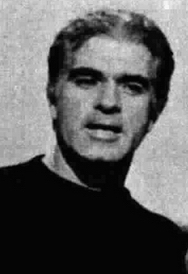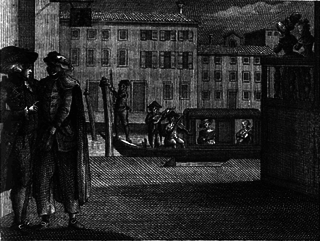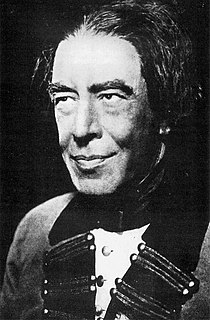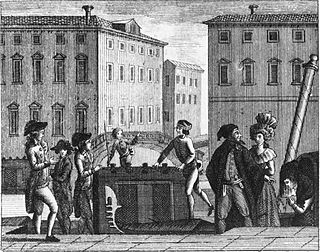External links
| This article on a play from the 18th century is a stub. You can help Wikipedia by expanding it. |
Il vero amico ("The True Friend") is a play by Carlo Goldoni written in 1750. It has been translated into English under the title The True Friend by Anna Cuffaro. The play is a comedy about two friends who are in love with the same woman.
In Memoirs (Carlo Goldoni's autobiography), Goldoni states: "This comedy is one of my favourites and I had the greatest pleasure in seeing that the audience confirmed my view" .
| This article on a play from the 18th century is a stub. You can help Wikipedia by expanding it. |

Carlo Osvaldo Goldoni was an Italian playwright and librettist from the Republic of Venice. His works include some of Italy's most famous and best-loved plays. Audiences have admired the plays of Goldoni for their ingenious mix of wit and honesty. His plays offered his contemporaries images of themselves, often dramatizing the lives, values, and conflicts of the emerging middle classes. Though he wrote in French and Italian, his plays make rich use of the Venetian language, regional vernacular, and colloquialisms. Goldoni also wrote under the pen name and title Polisseno Fegeio, Pastor Arcade, which he claimed in his memoirs the "Arcadians of Rome" bestowed on him.
This article presents lists of the literary events and publications in 1750.

Carlo, Count Gozzi was an Italian playwright and champion of Commedia dell'arte.
The Venetian Twins is a 1747 play by Carlo Goldoni, based on Plautus's Menaechmi.

The Servant of Two Masters is a comedy by the Italian playwright Carlo Goldoni written in 1746. Goldoni originally wrote the play at the request of actor Antonio Sacco, one of the great Truffaldinos in history. His earliest drafts had large sections that were reserved for improvisation, but he revised it in 1753 in the version that exists today. The play draws on the tradition of the earlier Italian commedia dell'arte.

Giorgio Strehler was an Italian opera and theatre director.
The Boors, also known as The Cantankerous Men, is a comedy by Carlo Goldoni. It was first performed at the San Luca theatre of Venice towards the end of the Carnival in 1760. It was published in 1762. The 'boors' are four merchants of Venice, who represent the old conservative, puritanical tradition of the Venetian middle classes, who are pitted against Venice's "new frivolity".

The Liar is a comedy by Carlo Goldoni. It was written as part of Goldoni's fulfilment of a boast that he had inserted into the epilogue to one of his plays that for the next season he would write sixteen comedies. The Liar, along with the fifteen other comedies, was staged in the 1750-51 season at the Teatro San Angelo in Venice. It draws on commedia dell'arte conventions and stock characters.
Venetian literature is the corpus of literature in Venetian, the vernacular language of the region roughly corresponding to Venice, from the 12th century. Venetian literature, after an initial period of splendour in the sixteenth century with the success of artists such as Ruzante, reached its zenith in the eighteenth century, thanks to its greatest exponent, dramatist Carlo Goldoni. Subsequently, the literary production in Venetian underwent a period of decline following the collapse of the Republic of Venice, but survived nonetheless into the twentieth century to reach peaks with wonderful lyrical poets such as Biagio Marin of Grado.

The Mistress of the Inn, also translated as The Innkeeper Woman or Mirandolina, is a 1753 three-act comedy by the Italian playwright Carlo Goldoni about a coquette. The play has been regarded as his masterpiece. Frederick Davies describes it as Goldoni's Much Ado About Nothing.

Le bourru bienfaisant is a French prose comedy in three acts by Venetian playwright Carlo Goldoni. In 1765 Goldoni became the Italian tutor of a daughter of Louis XV, Marie Adélaïde, who in 1769 was able to arrange for him an annual pension of 4,000 livres. He dedicated the play to her. It was premiered on 4 February 1771 by the Comédie-Française at the Théâtre des Tuileries in Paris and at court on 5 February. The play was highly successful and was published in 1771.
Il cavaliere e la dama is a comedy play by Venetian playwright Carlo Goldoni. It was published in 1749.
Il feudatario is a comedy play by Venetian playwright Carlo Goldoni. It was published in 1752.
Gli amori di Zelinda e Lindoro is a comedy play by Venetian playwright Carlo Goldoni. It was published in 1763.
Il teatro comico is a comedy play by Venetian playwright Carlo Goldoni. It was written in 1750.
I pettegolezzi delle donne is a comedy play by Venetian playwright Carlo Goldoni. It was published in 1750. It was written about two Italian women sitting at a fountain and gossiping. Columbina, a maid, and Isobella, Pantalone's daughter, are the two women. Pierrot, Columbina's husband, hears them gossiping and much hilarity ensues.

La putta onorata is a comedy play by Venetian playwright Carlo Goldoni. It was published in 1748. It is rooted to the styles of the commedia dell'arte. The play was applauded in the theater Sant'Angelo in the carnival of 1749 for 22 nights in a row.

The Teatro Goldoni is one of the opera houses and theatres of Venice. Today it is the home of the Teatro Stabile del Veneto. The modern theatre is located near the Rialto Bridge in the historic center of Venice.

La locandiera is a 1980 Italian comedy film directed by Paolo Cavara, based on the Carlo Goldoni's three-act comedy The Mistress of the Inn.
The Fan is a 1763 comedy by Carlo Goldoni. It was first produced as L´éventail in Paris at the Théâtre de la comédie italienne in May 1763, with little success. The French version is lost. Goldoni revised the play during 1764 as Il Ventaglio and it was premiered at the Teatro San Luca, Venice, in February 1765 with great success.